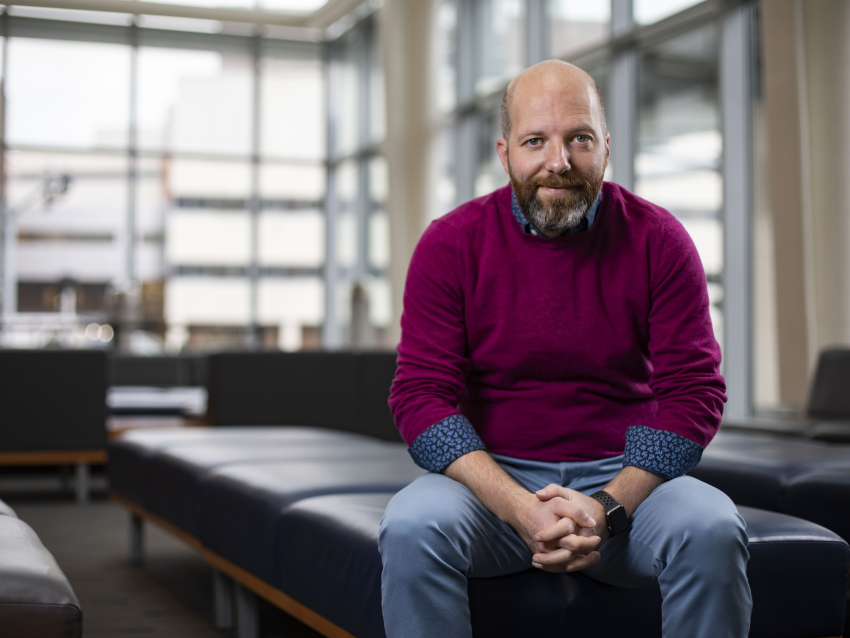
COVID-19 Vaccines: Fact vs. Fiction
We sat down with Vince Venditto, Ph.D., assistant professor in the department of Pharmaceutical Sciences at the University of Kentucky College of Pharmacy, to discuss the COVID-19 vaccines and distinguish fact from fiction. Venditto received training in organic synthesis and vaccine development and is now working on a clinical trial with community pharmacies to understand the prevalence of SARS-CoV-2 in Kentucky.
The vaccine may feel rushed but it’s safe.
Fact. While the timeline from the start of the pandemic to the approval of the vaccine has been faster than any other vaccine, the technology has been in development for many years. When mRNA vaccines were developed, the technology, which is the same as the technology behind Pfizer and Moderna vaccines, was touted as a quick and efficient method to produce vaccines at unprecedented speeds, and this proved true for this SARS-CoV-2. Pfizer and Moderna have been working in this space for many years and it was because of their strong foundation in this technology that they were able to generate a vaccine and mass produce it in less than a year.
Even on an accelerated timeline, the vaccine went through the required testing.
Fact. The COVID-19 vaccines, like all drugs that are approved for human use, undergo significant scrutiny from various independent evaluators to ensure efficacy and safety, during the clinical trials, and then by the FDA for approval. After FDA approval, safety and efficacy continue to be monitored for adverse effects. Some of the COVID-19 vaccines being tested in clinical trials were halted because of a serious illness in a few subjects, but were not associated with the vaccine. Pausing a clinical trial is a very common event and indicates that the independent safety monitoring boards are ensuring that only safe vaccines are approved for use. Since approval, there have been a few reports of rare, but serious allergic responses in a small number of patients, and the safety monitoring boards continue to evaluate these events to ensure the safety of all those who receive the vaccine. This is why you are required to wait 15 minutes after being vaccinated and before leaving the doctor’s office.
There’s an advantage to having multiple vaccines— not just one that works.
Fact. While one vaccine is a significant achievement, it is critical that multiple vaccines based on different technologies are approved for use. There are several reasons for this.
- The number of doses necessary to immunize the entire U.S. and the world is not practical using one vaccine given the different reagents necessary to produce the vaccines. Approval of multiple effective vaccines will reduce the burden on a single manufacturer to ensure that everyone across the world can have access to a vaccine in a timely manner.
- Not all vaccines work well in all populations. Historically, there are examples of vaccines that are more effective in specific ethnic populations for reasons that are not well understood. Because of this, multiple vaccines will ensure that everyone has access to an effective vaccine.
We know what’s in the vaccine.
Fact. We know exactly what is in the vaccine. This varies from vaccine to vaccine based on the companies’ specific design. The first two approved vaccines from Pfizer and Moderna contain oil droplets with genetic materials to express non-infectious pieces of the virus.
We don’t know anything about the side-effects.
Fiction. Each of the clinical trials is conducted in more than 30,000 people from around the world and all subjects are monitored for side-effects. Half of the subjects in the clinical trial are receiving a placebo and half are receiving the vaccine.
In general, people report soreness and swelling at the injection site, as well as fever, chills, tiredness, and headache, which should go away after a few days. This is exactly what you want to happen because this means your immune system is active and doing its job. The subjects in the clinical trials continue to be followed for any additional side-effects and none have been observed. Everyone who receives the vaccine in the trial or after approval will continue to be monitored for side-effects to ensure continued safety in all different populations and conditions.
COVID-19 will eventually go away on its own.
Fiction. It is unlikely that SARS-CoV-2 (COVID-19) will go away on its own. Just like the common cold, which is also a coronavirus, it continues to make kids sick every year. However, as we age and continue to be exposed to the virus, we generate an immune response that prevents us from getting sick. The vaccine helps accelerate this process to protect us. However, we are only a year into this pandemic and scientists will continue to monitor how many people are infected each year.
Receiving an mRNA vaccine does not affect your DNA/genetics.
Fact. The mRNA vaccine is a fantastic technology, because it has no way to get into your DNA but can still induce a strong immune response by generating pieces of the virus for our immune systems to respond to. Once the mRNA is used by our cells it is destroyed and has no long-term effects on our cells.
The vaccines are real; they are not just placebos.
Fact. Clinical trials require vaccine groups and placebo groups to show that the vaccine is effective. Once a proper comparison between these groups can be made, all vaccines contain the active ingredients to induce an effective immune response to the virus.
There’s a chip or marker in the vaccine to track you.
Fiction. This is just not true.
People with allergies to egg-based medicines can’t get the vaccine.
Fiction. The Pfizer and Moderna vaccines are not made with eggs. So, an allergy to egg-based medications doesn’t really come into play. Per the Center for Disease Control (CDC) if you have had a reaction to another type of vaccine, you should consult with your doctor as to how best to proceed.
